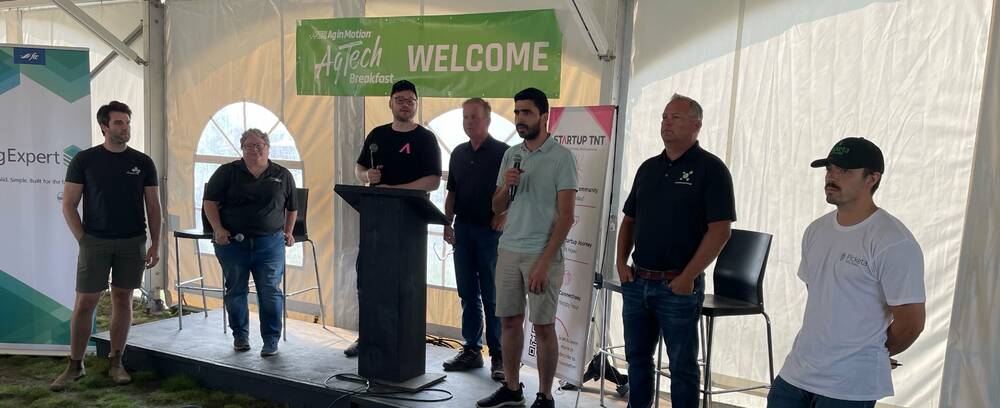Entrepreneurs tout products at Ag in Motion event

Entrepreneurs pitched their products at Ag in Motion’s AgTech Breakfast.
Trevor Scherman, co-founder of Combine Settings, was first up to talk about his website, designed to help farmers reduce harvest losses.
“Losses at harvest are astronomical,” he said during the event hosted by Startup TNT.
Canola farmers lose an average of 1.3 bushels per acre. At $15 per bushel, that’s a $409 million hit to the Prairie farm economy. Growers can use the site to tap into the knowledge of fellow farmers running the same equipment in the same condition with the same after-market parts.
Read Also

Fuel hedging platform wins AIM innovation award
Rack Petroleum Ltd.’s HedgeHog app allows users to confirm a guaranteed price for diesel for future delivery up to two years into the future.
“Once you put after-market parts in the combine, they just perform differently,” said Scherman.
The company has a theory on why harvest losses exist.
“Lots of people don’t understand how the combine works anymore,” he said.
Combine Settings provides young farmers with the ability to tap into an online network of older farmers who can share some generational knowledge.
Tayab Soomro, co-founder of PathoScan, summed up his company in one succinct sentence.
“We have developed a device that allows farmers to test for crop diseases right in their fields,” he said.
He described it as similar to a COVID rapid test, only it works better. Labs still perform a valuable role, but this product is designed for farmers who need to make on-the-spot decisions.
“That is our real value, which is to get the farmers a basic answer of whether or not they need to spray for this disease today or tomorrow,” said Soomro.
Zachary Anderson, vice-president of sales with Picketa Systems, was promoting an optical sensor that can scan plant tissue and return tissue analysis in real time.
The founder of the company designed the device for potato growers in New Brunswick. He wanted to provide farmers with the same information they get from a lab but whenever and wherever they need it.
He has since trained the device to work on corn crops and is in the process of adapting it for canola.
“We’re hoping to have a canola model up and running in 2025 for the next growing season,” said Anderson.
Drew Sharp, agribusiness manager for Phytokana Ingredients Inc., said the company is in the process of building a fababean protein fractionation plant in Strathmore, Alta.
The plant will be capable of processing 30,000 tonnes of fababeans per year once it is up and running in winter 2025. The company is currently contracting acres with growers.
Sharp encouraged farmers to consider growing fababeans, a crop that is resistant to Aphanomyces and delivers higher yields than peas.
“It is one of the highest return-per-acre crops you can plant,” he said.
Brita Lind is chief strategy officer with Prairie Clean Energy, a company that processes flax straw at its Regina plant.
Growers in Canada and the United States typically burn about 1.1 million tonnes of flax straw per year.
“Now farmers can get two incomes out of one crop,” she said.
The straw is processed into pellets that are sold to bioenergy companies for heat, power and gasification.
“Also, it makes amazing horse beds,” said Lind. The company is selling the pellets to Amish farmers in the northeast U.S.
“They’re picky about their horses, I’m telling you,” she said. “They love it. They can’t get enough of it.”
Prairie Clean Energy has right-of-first- refusal agreements with about 100 farmers. But there’s not a lot of competition for that straw.
“There’s no one else doing this on the Prairies,” said Lind.
Terry Nieth, said CarbonWorks CetaiN is a carbon-based nitrogen enhancement product that keeps nutrients in the soil until your crop is ready to use them.
It also stimulates microbial activity in saturated soils by delivering a timely supply of molecular oxygen to the root zone. It can go on UAN at 3.0 litres per tonne and can coat urea at 2.6 litres per tonne. The product mitigates the smell of UAN.
“That tells you that it’s holding onto it,” said Nieth.
An independent lab analysis shows it reduces emissions by about 22 per cent.
Nieth said growers can get an extra five to 10 bushels per acre versus non-treated crops, simply by saving nitrogen.
Source: Farmtario.com

